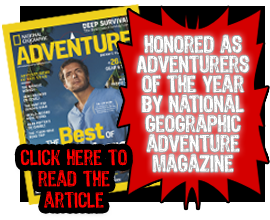On October 7th we left Ulaanbaatar for Western Mongolia. With a Lonely Planet guide and a China/Mongolia map our confidence was high that we should not have to many problems making our way to the Russian border. The last night before we left Chinzorig gave us a quite helpful piece of advice. He told us, "Don’t follow the road, follow the bearing." He was referring to the bearing on the compass. When we braved the Gobi from China before our confidence led us to believe that the trip west could not be much more difficult. To put it simply…We were wrong.
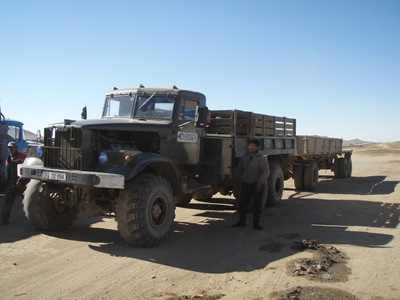 The initial calculations of the time it would take to get to Russia had us pegged at a total of 7 days. This total would put us into Russia allowing 3-4 days for some "excursions" on our way. According to the many that we talked to, driving long days would allow us to get to the border in 3 days. With our new shocks and recent days of maintenance on the trucks, there could be no way that we would not be able to make it to the border in under 7 days. Then came the first day.
The initial calculations of the time it would take to get to Russia had us pegged at a total of 7 days. This total would put us into Russia allowing 3-4 days for some "excursions" on our way. According to the many that we talked to, driving long days would allow us to get to the border in 3 days. With our new shocks and recent days of maintenance on the trucks, there could be no way that we would not be able to make it to the border in under 7 days. Then came the first day.
Since Steve B and Brandon had already gone west once before for the wedding, we had a little intel on the first part of the drive. With smiles on our faces for the impending adventure, we were off. The first 4-5 hours provided for smooth sailing on newly paved roads and well traveled tracks. My excitement grew when passing the biggest most burly trucks in the world. About an hour later, my excitement turned to frustration as Bouey came rallying up next to Brandon and I trying to get us to stop. Moments later we were struck by the fact that we may no longer be on the main road. Steve B could not say for sure, but he did not think this was the road as the bearing was starting to veer farther and farther from West.
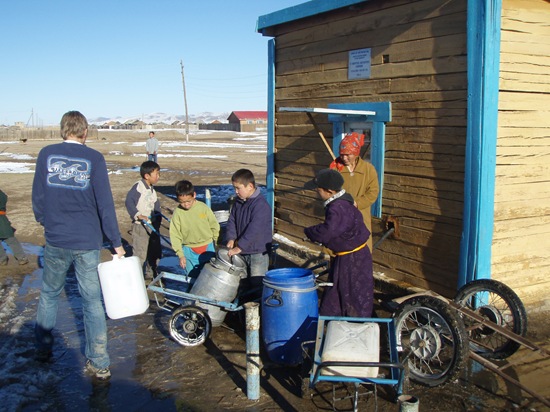
We found out 20 km later that we were in fact on the wrong road. The diversion did lead us to a small village where we were able to brighten the villagers day with an appearance from the crew. They helped us get much needed water from the well in town. As soon as we arrived the 2-3 people at the well grew to about 10-15. Everyone was giving us advice on things ranging from which direction to go for the main road to invitations to eat at the local restaurant (or building where they serve food). One man so kindly gave me some hand signals indicating that if I drink the water something not so pleasant will come out the other end. A half hour later we were heading back on the road we came in on trying to figure out where we went wrong.
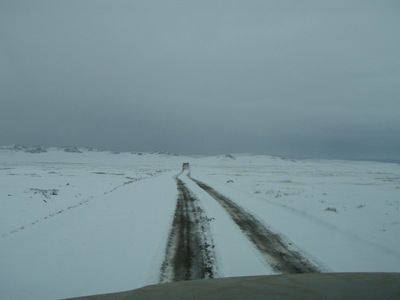 Like the many confusing times getting lost that would follow, a simple statement sums up getting back on the right path…"How could we have missed the main road?" In Western Mongolia especially, there are so few drivers that there really is not a main road. Sometimes the paths will have more traffic or be smother than one another, but still do not qualify as proper roads. The only thing that you can really know for sure is that you need to go around a certain number of kilometers in a certain direction. Eventually you are supposed to hit a town or somewhere that should have gas. Most of the time the town does not come soon enough or the track you are on veers the wrong way, and thoughts of running out of gas, water and food flood your mind. With the temperature consistently below zero, these fears put a real damper on your spirits. It was so cold that we had to keep water and liquids inside our sleeping bags at night so they would not be frozen in the morning. In the end it seems only proper to clarify that in Mongolia there is a "way" to get from one place to another, but one thing will be guaranteed…this way will be an adventure packed full of twists and turns.
Like the many confusing times getting lost that would follow, a simple statement sums up getting back on the right path…"How could we have missed the main road?" In Western Mongolia especially, there are so few drivers that there really is not a main road. Sometimes the paths will have more traffic or be smother than one another, but still do not qualify as proper roads. The only thing that you can really know for sure is that you need to go around a certain number of kilometers in a certain direction. Eventually you are supposed to hit a town or somewhere that should have gas. Most of the time the town does not come soon enough or the track you are on veers the wrong way, and thoughts of running out of gas, water and food flood your mind. With the temperature consistently below zero, these fears put a real damper on your spirits. It was so cold that we had to keep water and liquids inside our sleeping bags at night so they would not be frozen in the morning. In the end it seems only proper to clarify that in Mongolia there is a "way" to get from one place to another, but one thing will be guaranteed…this way will be an adventure packed full of twists and turns.
To keep a long story short, this scenario continued for the next week. We barely made it out of Mongolia driving seven full days in a row. Countless families living in gers were disturbed by two huge trucks with westerners asking directions. I am convinced that we were the only foreigners that many of these nomads had ever seen. These kind hearted people never 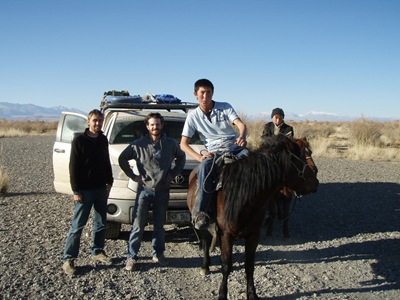 thought twice about helping us in our quest for the Russian border. Although the only help many of them could give us was pointing in the direction we should drive (sometimes in a direction that would lead across a field with no tracks at all), often they would even ride horses or camels to lead us back to the main road. One time an excited old man gathered up his friends to help him push start his motorcycle so that he could lead us the right way. The generosity and kindness of these wonderful people not only helped us find our way, but is some circumstances saved our lives.
thought twice about helping us in our quest for the Russian border. Although the only help many of them could give us was pointing in the direction we should drive (sometimes in a direction that would lead across a field with no tracks at all), often they would even ride horses or camels to lead us back to the main road. One time an excited old man gathered up his friends to help him push start his motorcycle so that he could lead us the right way. The generosity and kindness of these wonderful people not only helped us find our way, but is some circumstances saved our lives.
This experience is something that I will never forget. For seven days we never really knew where we were going or where we were. It is a scary feeling to rely on nothing more than a compass and odometer to find your way. Without a doubt I have never been so lost in my life. Some days we would not pass another person the entire day. Driving ten hours without seeing another soul makes you second guess any path you choose, but in this area of the planet it is something you just have to get used to. We braved the wild west with no guides and some of the worst maps I have every used. I do not know if we will encounter such raw and challenging travel again, but road signs and pavement have certainly raised their level of importance in my book.
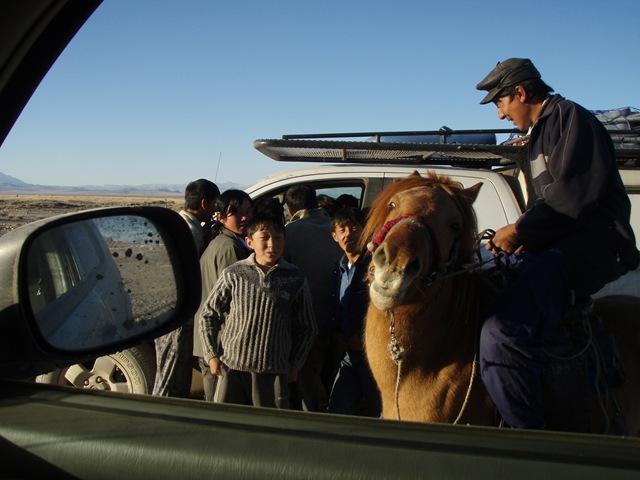
Even the animals want to help with directions.
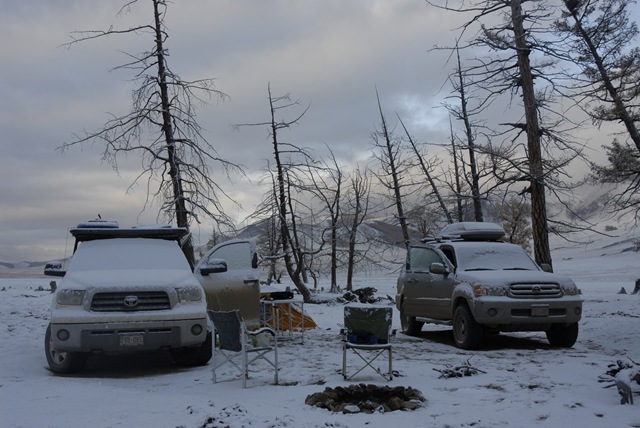
Brrrr. We woke up to snow at least half of the mornings.
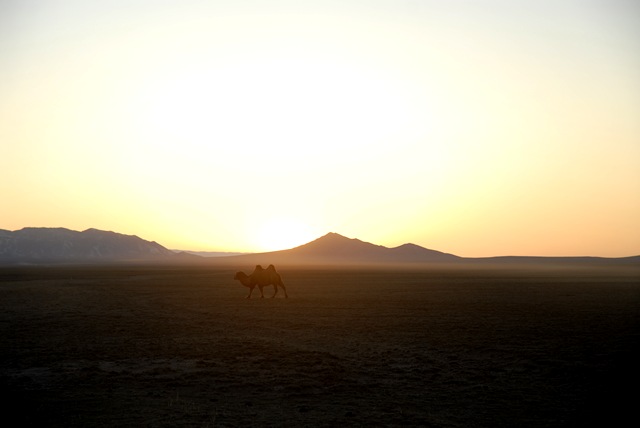
Drive across the field, around the camel, and their might be a road on the other side.
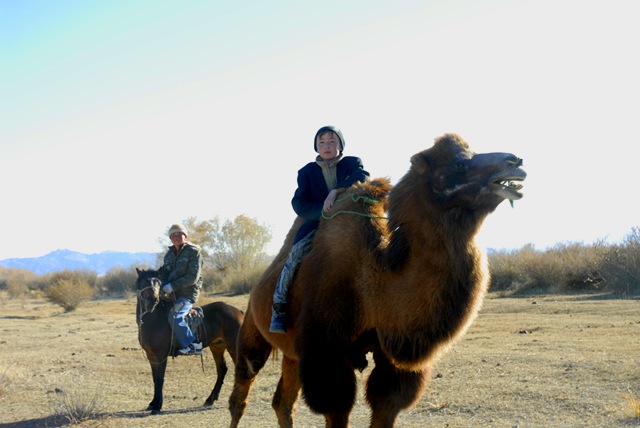
Our fearless guides for about a half an hour. We met them in the middle of this field.
